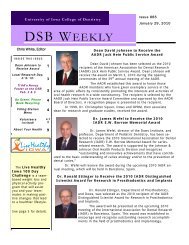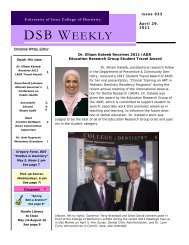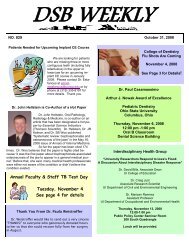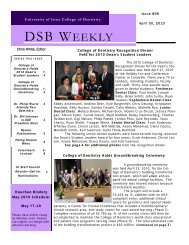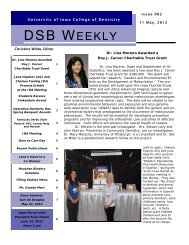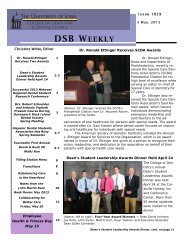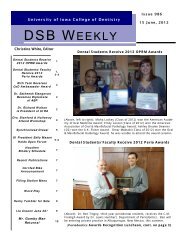Iowa Section of AADR - The University of Iowa College of Dentistry
Iowa Section of AADR - The University of Iowa College of Dentistry
Iowa Section of AADR - The University of Iowa College of Dentistry
Create successful ePaper yourself
Turn your PDF publications into a flip-book with our unique Google optimized e-Paper software.
23. <strong>The</strong> Effect <strong>of</strong> Maxillary Restriction on Mandibular Fossa Morphology<br />
J. Kelly 1 , N.E. Holton 1 , S.D. Marshall 1 , R. Franciscus 1 , T.E. Southard 1<br />
1 <strong>University</strong> <strong>of</strong> <strong>Iowa</strong><br />
Objectives: In previous analyses, we found that experimentally-induced maxillary restriction in a pig model<br />
resulted in predictable changes in mandibular condylar morphology. In the present study we extend our analysis to<br />
assess the potential effects <strong>of</strong> maxillary restriction on the morphology <strong>of</strong> the mandibular fossa.<br />
Methods: Ten female domestic pig sibship cohorts, each consisting <strong>of</strong> three individuals, were allocated to one <strong>of</strong><br />
months. <strong>The</strong> sham group underwent surgery, receiving only screw implantation, and the control group underwent<br />
no surgical procedure. Pigs were euthanized at six months <strong>of</strong> age. Mandibular fossa length and breadth were<br />
assessed using the Mann-Whitney U-test. Additionally, we assessed variation in mandibular fossa size and shape<br />
via geometric morphometric analysis <strong>of</strong> coordinate landmark data describing the fossa. To assess these data,<br />
we used Procrustes analysis, which distills a form, represented by coordinate landmark data, into size and shape<br />
information. Shape differences were quantitatively assessed using principal components (PC) <strong>of</strong> Procrustes scaled<br />
coordinate landmarks.<br />
Results:<br />
differences in shape. <strong>The</strong> results <strong>of</strong> our principal components indicated that the experimental group, relative to<br />
the control and sham groups, had a more superiorly positioned joint surface with lateral displacement relative to<br />
(from our previous analysis) describing differences in mandibular condylar morphology (r=0.49; p=0.012).<br />
Conclusions:<br />
This suggests that altering maxillary growth may have important consequences on masticatory function and joint<br />
biomechanics.<br />
Supported by: <strong>University</strong> <strong>of</strong> <strong>Iowa</strong>, <strong>College</strong> <strong>of</strong> <strong>Dentistry</strong>, <strong>Iowa</strong> Dental Research Grant<br />
24. Effect <strong>of</strong> Benzalkonium Chloride Adhesive System on Resin-Dentin Bond Durability<br />
A. Murray 5 , M.A. Vargas 5 , S. Geraldeli 9 , F. Qian 8 , L. Chen 7<br />
5 <strong>University</strong> <strong>of</strong> <strong>Iowa</strong> <strong>College</strong> <strong>of</strong> <strong>Dentistry</strong>, <strong>Iowa</strong> City, IA; 7 Research and Development, Bisco, Schaumburg, IL;<br />
8 Department <strong>of</strong> Preventive and Community <strong>Dentistry</strong>, <strong>University</strong> <strong>of</strong> <strong>Iowa</strong>, <strong>Iowa</strong> City, IA,; 9 Restorative Dental<br />
Sciences, <strong>University</strong> <strong>of</strong> Florida, Gainesville, FL<br />
Objectives: <strong>The</strong> resin-dentin bond is degraded by endogenous dentinal proteinases activated by acidic compounds<br />
contained in dental adhesive systems. Several compounds have been suggested to neutralize these proteinases,<br />
including benzalkonium chloride (BAC). <strong>The</strong> objective is to evaluate the effect <strong>of</strong> incorporating various<br />
concentrations <strong>of</strong> BAC on the short and intermediate bond strength <strong>of</strong> a one-step self-etch adhesive.<br />
Methods: Forty-eight human molars stored in 0.5% chloramine solution were used within 3mo <strong>of</strong> extraction<br />
and randomly assigned to 4 groups (n = 12). Flat dentin surfaces were prepared with a water-cooled, low-speed<br />
diamond saw (Isomet1000, Buehler). A standardized smear layer was prepared using 600-grit wet sandpaper.<br />
Three experimental one-step self-etching adhesives (Bisco Inc.) were formulated with 0.1%, 0.2% and 0.5% BAC<br />
following manufacturer’s guidelines. A three increment build-up <strong>of</strong> approximately 5mm was made using resin<br />
composite Estelite Sigma Quick (Tokuyama). Each increment was light cured (690-730 mW/cm 2 ) for 20sec with<br />
sectioned to obtain six rectangular sticks from the central part <strong>of</strong> the bonded surface with a cross section area <strong>of</strong><br />
approximately 0.8mm. At random, two sticks from each group were subjected to tension at a crosshead speed <strong>of</strong><br />
1.0mm/min using a Zwick testing machine at 1wk and two sticks at 10wks.<br />
Results: A two-way repeated measures ANOVA was used to evaluate differences among the groups by adhesive and<br />
23 22



